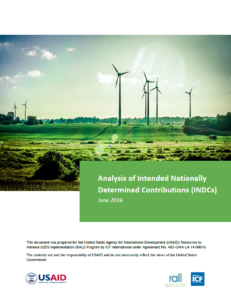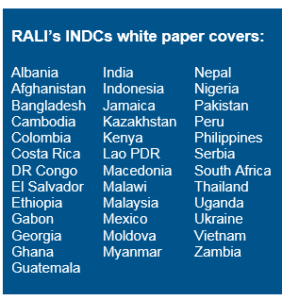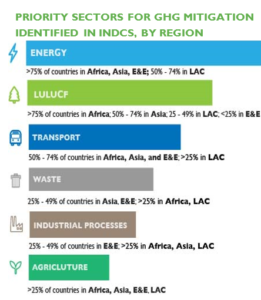Leading up to the UNFCCC Conference of Parties (COP 21) in Paris in December 2015, countries submitted their Intended Nationally Determined Contributions (INDCs), outlining the post-2020 climate actions that each country intends to take. INDCs, which describe long-term greenhouse gas (GHG) emissions reduction pledges by each country, form the building blocks of the Paris Agreement. As countries formally join the Paris Agreement, the term “intended” is no longer needed and their commitments are referred to as Nationally Determined Contributions (NDC).

To help climate change practitioners understand the commitments made in INDCs and to support strategic decision-making, the United States Agency for International Development (USAID) Resources to Advance LEDS Implementation (RALI) Programme recently undertook an analysis of 37 INDCs, including Nigeria, who are primarily partner countries in the U.S. Government’s Enhancing Capacity for Low Emission Development Strategies (EC-LEDS) programme. Each country profile in the “Analysis of Intended Nationally Determined Contributions” provides an overview of the country’s climate strategy based on information from the INDC; key documents such as National Communications and Biennial Reports; and external data sources.
For each country analysed, the RALI report summarises the:
- Unconditional and conditional GHG emissions reduction targets
- Analytical basis for developing the emissions reduction targets
- Mitigation actions being undertaken by the country
- Adaptation strategies
- Existing policy framework of the country’s INDC
- Financial and technical assistance requested
Each country profile also includes insights on data quality and transparency, the most recently submitted GHG inventory to the UNFCCC, national GHG emissions by sector, and key documents for further consultation.

Key Findings.
The RALI analysis resulted in several topline findings:
- A majority of the countries included conditional commitments
- Few countries offered detail on the analytical basis of their proposed goals
- While many countries stated that they need financial assistance to implement their INDCs, few explained how much assistance was needed
- Most countries developed their INDCs based on current existing policies and plans, such as their Nationally Appropriate Mitigation Actions (NAMAs)
The findings suggest that countries may need support in refining mitigation goals, assessing costs, and prioritising needs as they finalise their INDCs and ratify the Paris Agreement.
RALI also analysed the selected INDCs for sectoral trends. Over 80% explicitly identify the energy sector as a priority area. LULUCF is the second most common sector, with countries outlining activities related to improving forest management, forest law management, land rehabilitation, and participation in REDD+. Transport is the third most prevalent, with countries indicating an intention to expand mass transportation, adopt cleaner vehicle fleets, and transition to cleaner fuels.

NAMAs
Several countries identified NAMAs as either a useful basis upon which to build their targets, or as a possible mechanism to help implement their targets. Some countries noted that their existing NAMA submissions informed the mitigation actions they proposed to fulfill their target. Ghana, for example, used its existing NAMA submissions to better understand what measures are feasible to implement and what resulting emission reductions could be expected. Some countries also emphasised their intention to use NAMAs as mechanisms for meeting their emission reduction targets. Because NAMA development provides countries with clear, linear paths to mitigation funding, at least one country noted that the implementation of their NDC depends on international support through the NAMA framework.
With the Paris Agreement entering into force this year, countries will need to begin refining and implementing the activities outlined for each sector in their INDC. For many countries, NAMAs will be the main instrument to map out and implement their mitigation actions. NAMAs and the NAMA registry can support countries in meeting the transparency requirements under the Paris Agreement and provide countries with a pathway to access financing.
More information on the INDCs of EC-LEDS and other selected countries can be found in the “Analysis of Intended Nationally Determined Contributions” developed by ICF, implementre of the USAID RALI project.
